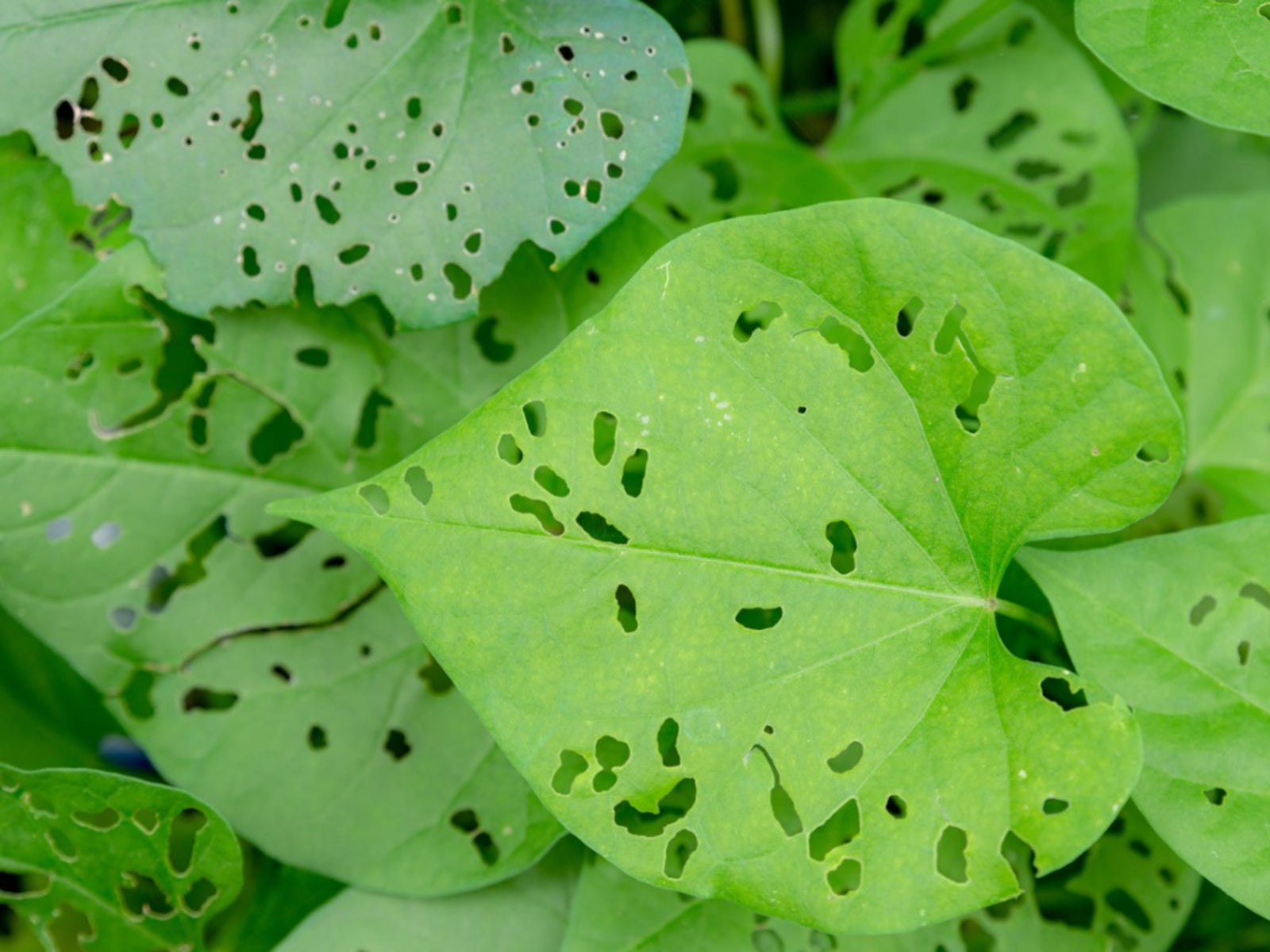As a sunflower grower, waking up to find ragged holes chewed in your plants’ leaves can be alarming. A variety of hungry pests could be the culprits behind the nighttime leaf damage Identifying the exact culprit allows you to take steps to control them and protect your sunflowers.
Common Sunflower Leaf-Eating Pests
Caterpillars – Nearly 40 species of moth and butterfly caterpillars are known to feed on sunflower foliage. Some of the most notorious include corn earworms, sunflower moth caterpillars and painted lady butterfly larvae. They chew large irregular holes in leaves.
Japanese beetles – These small metallic green and copper beetles devour leaves between veins, leaving behind skeletonized foliage. They feed in groups so damage appears extensive.
Grasshoppers and katydids – Both immature and adult stages of these jumping insects chew sunflower leaves. They leave behind ragged holes of varying sizes depending on species.
Sawfly larvae – The caterpillar-like larvae of various sawfly species eat leaves from the edges inward, resulting in notched or scalloped leaf margins. They often feed in groups.
Cutworms – The plump, soft-bodied larvae of several moth species chew leaves at night. During the day, they hide in soil around plant stems.
Earwigs – These creepy-looking insects feed at night, leaving behind ragged, irregular holes in foliage. They seek shelter in leaf axils during the day.
Slugs and snails – These mollusks rasp away leaf tissue leaving behind irregular holes with smooth edges. Their slime trails are a telltale sign of their leaf damage.
How to Find the Culprits
Carefully inspect plants in the early morning or at night with a flashlight to catch nocturnal pests in the act of feeding. Check both the tops and undersides of leaves, as many pests feed from underneath. Shake foliage over a sheet of white paper to dislodge small insects for better viewing.
Also search for signs like fecal pellets, chewed leaf margins, slimy trails, or nests. Capture a sample insect in a sealed jar for identification. Compare against images online or consult your local extension office.
Effective Ways to Control Sunflower Leaf Pests
Manual removal – Handpick larger pests like caterpillars, beetles, or earwigs and drop them into soapy water. Be diligent, as they can reinfest quickly.
Row covers – These lightweight fabrics act as a physical barrier against pests when installed over plants. Secure the edges well.
Pesticides – Insecticides derived from Bacillus thuringiensis (BT) effectively and safely target leaf-eating caterpillars and sawfly larvae when applied early.
Natural predators – Attract beneficial insects like ladybugs, lacewings, and parasitic wasps which prey on problem pests. Avoid broad-spectrum pesticides that kill them.
Companion plants – Interplanting aromatic herbs like basil, thyme, or chamomile can help repel some pests through their strong scent.
Crop rotation – Rotating annual crops in different beds each season denies pests their preferred food source.
Sanitation – Promptly remove and destroy heavily infested plants and prune out damaged leaves. This eliminates pests and eggs before they spread.
Resistant varieties – Some sunflower hybrids have been bred with genetic resistance to common pests like aphids, beetles, or downy mildew.
Repellents – Spraying plants with lightweight horticultural oil or insecticidal soap deters feeding and disrupts insect reproduction. Reapply frequently.
Preventing Sunflower Pest Problems
Implementing preventive measures is key to avoiding serious leaf damage:
-
Maintain healthy soil with compost to reduce plant stress. Stressed plants are most vulnerable.
-
Avoid overcrowding and space plants appropriately to allow air circulation.
-
Water at the base and avoid wetting foliage excessively.
-
Apply mulch around plants to prevent weeds, conserve moisture, and hide pests.
-
Check plants frequently and take quick action at first signs of damage before pests multiply.
-
Remove spent plants and debris at season end to eliminate overwintering sites for pests.
By moving swiftly at the first sign of chewed foliage, you can protect your sunflowers and enjoy watching them flourish. With persistence and varied control methods, you can outsmart those leaf-munching pests.

Banded sunflower moth
Cochylis hospes
Description Banded sunflower moths are a threat in all sunflower growing regions. Lice are pink-red or green, but adults have a dark brown triangle-shaped band across the middle of their wings. Most of their eggs are laid on the outside ring of seeds in the sunflower head, but some may also be laid on the bottom. In their later stages, larvae move toward the face to eat florets and pollen before moving on to sunflower seeds, where each insect attacks more than one seed. Feeding larvae can prevent proper plant development and significantly reduce seed count, reducing yield and quality. Symptoms.
- Inadequate pollination due to larvae feeding on florets and pollen
- Larvae are eating when sunflower heads have webs that look like silk.
- Empty seeds from feeding larvae
- Banded sunflower moth damage is usually less likely to happen to crops that were planted late.
- The best times to look for banded sunflower moths are early in the morning or late at night.
- Use insecticides like Warrior II with Zeon Technology®, Besiege®, or Karate with Zeon Technology®.
Description There are many different cutworm species that feed on sunflower, most often right after emergence. For most species, eggs laid the previous summer hatch each May or June. Cutworms feed on leaves and cut through stems to hurt young plants, both above and below the soil. Cooler soils with a lot of water stop sunflowers from growing and tend to make stands shorter and make cutworm damage worse. Cutworms usually stay dormant during the day and only move a few inches away from an infected plant at night to eat. Symptoms.
- Small, transparent spots on leaves from young larvae feeding
- Wilted, severed or dying seedlings resulting from older larvae feeding
- When plants are planted in fields that are already infected, notches can show up in the leaves or cotyledons.
- Look for cut plants at least twice a week when they first come up.
- In the day, dig around plants that are hurt to look for cutworms.
- Tillage can reduce infestations
- To stop cutworms from eating above ground, use Besiege or Warrior II with Zeon Technology insecticide at emergence or right before it happens.
Downy Mildew
Plasmopara halstedii
Description A result of the soilborne fungal pathogen Plasmopara halstedii, downy mildew can attack plants in two waves. The main infection that affects the whole plant is more troublesome. Secondary infections that are caused by wind-blown spores from infected plants are usually not bad enough to significantly lower yield or quality. When the pathogen gets into the roots of sunflower seedlings, it causes systemic infections. This usually kills the plants and greatly reduces the size of the stand. When the disease is distributed sporadically across fields, unaffected plants often compensate to minimize yield loss. However, widespread infections can cause significant yield loss as healthy plants are unable to compensate. The pathogen grows best in cool, wet places and can stay in the soil for up to 10 years, so taking precautions is very important to lower the risk of infection. Symptoms.
- Systemic infection
- Wilted, severely dwarfed or dead sunflower seedlings
- Thick and yellow (chlorosis) cotyledons along foliage veins
- White cotton-like material on the underside of infected leaves
- plants that are only 6 to 8 leaves and are moderately stunted; foliar symptoms only show up on the upper leaves in delayed infections
- Secondary infection
- Small, “local” lesions appear on foliage
- White, cotton-like material on the underside of local lesions
- Get rid of weeds to stop the pathogen from spreading to other hosts.
- CruiserMaxx Sunflower plus Bion® is a combination of two separately registered products that can be used to treat sunflower seeds.
- Apply Quadris fungicide for foliar control
How to Protect Your Sunflowers From Pests in Southern Arizona
FAQ
How do I stop bugs from eating my sunflowers?
What’s eating the leaves on my sunflower plants?
What is the best insect spray for sunflowers?
Why do my sunflower leaves have holes?
